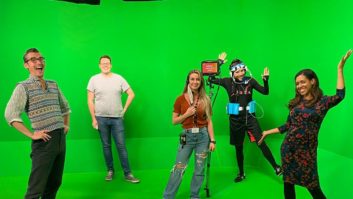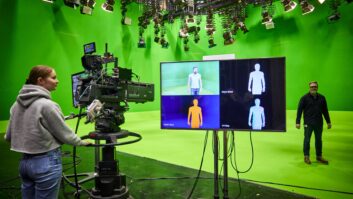This year sees dock10 turn ten-years-old. Looking back, it’s been a truly incredible decade of growth, development and success for the business, and it’s seen some truly fundamental advances in the technology we use to make television. Some of the things we are regularly using today were embryonic when dock10 was created in 2011—think 4K or virtual sets. It’s been quite a journey, and one worthy of brief reflection.
Based at the heart of Media City, dock10 was born out of the BBC’s plan to move key elements of its television operations, including BBC Children’s and BBC Sport, outside of London to Salford Quays in Greater Manchester. At the time there was criticism that the BBC was too focused on producing content within London, and Mark Thompson, the then director-general, was keen that the BBC should, in his own words, “serve and represent the whole country, not just its capital.” This ambition required a major new television facility equipped to support the creation of world-class content outside of London – dock10 was born.
Back in 2011, dock10 was little more than an enormous studio in the middle of a ghost town. But as MediaCity emerged around us, we also continued to grow and evolve. At that time, next-generation technology was just emerging and as we built dock10 we were able to incorporate it into the design, such as the latest IP network, centralised and virtualised technology. It was a smart investment that has served us well over the last ten years, but technology never stands still and we are constantly refreshing, updating and upgrading to ensure we keep ahead of the curve. Today dock10 is the UK’s leading television facility and our eight permanent television studios and two outdoor spaces are fully equipped to handle any size or type of television production.
All our studios have their own unique characteristics, ranging in size from the UK’s biggest multi-camera TV studio (12,540 sq ft with an audience capacity of 1,000 people) to small studios designed for 24/7 continuity for dedicated channels. We have recently invested £1 million in a new gallery solution for our smallest studio, HQ8 (713 sq ft), to meet the increasing demand for virtual studios and remote galleries. But what I think makes our studios really stand out is that they all share the same high-spec technology. They all have similar cameras and technical equipment, all are equipped with virtual studio capabilities, all have state-of-the-art interlinked galleries, and all are connected to dock10’s unique infrastructure. This is great for customers as our connectivity and flexibility means any studio can incorporate whatever technology is needed; so every production can find the right size and spec of studio space for their particular production.
Operating over 50 fully-equipped edit suites with Flame and Baselight capability and 4K monitoring, we employ the latest technology, including Avid edit suites with Avid MediaCentral | Production Management, Avid Pro Tools audio suites with Source Connect voice booths, Baselight and Lustre for grading and the latest Autodesk Flame suites for VFX. We have grown to have a ten-person graphics studio and state-of-the-art dubbing suites operating Pro Tools S6 M40 desks. About five years ago, we built our boutique facility ‘The Quay’, which has ten offline and two online suites, four VFX suites, a motion graphics area and an expanded grade facility with built-in projector. Over the last few years, we have increasingly set ourselves up for remote working and even have a helpline for editors working from home. This allowed us to hit the ground running when the global pandemic forced the nation into lockdown.
What I enjoy most about our industry is that it never stands still and dock10 has a great reputation for technological innovation and for taking the latest developments from theory into practice. We love to explore new technology, rolling up our sleeves to see how it works, how it can be used, and how it can help our customers. For me, I think some of the biggest technology shifts of the last decade have been in UHD/HDR, augmented and virtual reality, and remote production, all of which I’m proud to say dock10 has fully embraced and often actively pioneered.
For most viewers, television is about what they see on screen and recognising that 4K UHD/HDR was likely to become the new standard, we have reconfigured our entire facility around this exciting technology. We’ve invested in 15 Sony HDC-3500 4K cameras, as well as vision mixers, multi-viewer monitors and core routers; more than this, our 200GBps network was developed specifically to smooth the way for 4K UHD/HDR and VR/AR. It is connected to all ten television studios and their galleries, as well as all 50 post production suites, our ingest, control rooms and the data centre. Built to extremely impressive technical specifications, the network comprises of two interlinked elements with a Control LAN monitoring and managing studio and gallery equipment in real time, while a Production LAN is dedicated to supporting 4K file-based content workflows. Constantly monitored by the latest software control tools and detailed analytics, our broadcast network is a dedicated standalone network used exclusively for broadcast content and comes complete with all the latest cyber security safeguards.
What this delivers for our customers is spectacular advantages and efficiencies. For example, a UHD television show captured in any of our studios can be made instantly available for editing and then sent directly for transmission from post production, delivering clients exceptionally fast turnaround of UHD programmes. Similarly, our network allows 4K contributions for live shows to be edited in dock10’s post production suites and be available immediately for live playout, allowing changes to be made right up to transmission. Most recently, we supported BBC Sport’s delivery of their Euro 2020 coverage in UHD, rising to the challenge of integrating the UHD elements throughout the broadcast chain, upgrading all the necessary technology and then delivering the UHD workflow into iPlayer. The resulting picture quality was exceptional and significantly enhanced the viewer experience.
We have also been at the forefront of developing and deploying virtual studio technology, something we have taken a unique approach to. Typically, people think of a virtual studio as a room with green walls and a green floor. However, a single virtual studio can be restrictive in size and space, so we have given all of our studios virtual capability so that we can add virtual and augmented elements to any size of show. All the technology is centralised in our CTA and can be deployed to any or all of our television studios at any time so that creative directors can choose the right size studio for their requirements. It’s a really revolutionary approach and we have been taking calls from facilities all around the world asking us how we do it!
As for the technology, what excited us was the possibilities coming out of gaming. We saw the opportunity to take green screen to a whole new level by using the real-time photorealistic graphic rendering which makes the virtual environment look indistinguishable from the real world. The film industry has been doing this for years, but by putting the actor into a green screen for the impossible shot and then adding the virtual world in post. Now, thanks to advanced camera tracking and graphic processing, we can do the whole shot in real-time, live on screen, so the director will see what the viewers will see! These advances are breathtaking and broadcasters like the BBC were early adopters, using our virtual studios for Match of the Day. Then, when the schools closed for lockdown, we created the virtual classroom for BBC Bitesize Daily in record time and have gone on to create a second series with a hugely expanded virtual set enhanced by an augmented reality robot; all in real time.
Even before the pandemic, we were already using remote production to transform the way live sports events were broadcast. With lockdown and broadcasters anxious to minimise crews at live events, more and more turned to our remote production capabilities that enable production to be handled from galleries in a studio here at dock10. To support this, we invested £1 million in a dedicated multipurpose remote gallery that works seamlessly with outside broadcasts and connects to the dock10 network. The last 18 months has proved how well remote production works, with dock10 becoming a hub for coverage of events including the FA Cup, the Euros, and the Olympics. And beyond the pandemic, I believe that remote production will continue to play a big role as broadcasters and producers use it to reduce their carbon footprint and create content in a more sustainable, cost-effective way.
Looking ahead, a major area of focus for us will be expanding virtual and augmented reality into more entertainment shows. I believe that whatever the next big global format is, it will use VR and AR to bring to life an idea that we were told was impossible or too expensive, giving entertainment formats an extra dimension. Let’s say you’ve got a daytime game show, for very little it’s suddenly looking like prime-time Saturday night. Or an entertainment show with spin-off, behind-the-scenes or interview segments where each segment is branded differently but using the same space and with speedy turn-around. We’ve been working with producers to use the system on a children’s programme, a game show pilot and a live entertainment production, and the huge success of bringing the Gran Turismo Championship to ‘virtual’ life here at dock10 earlier this year was a real boon for our ambitions.
We’ll also be making more of our UHD/HDR capabilities in our studios, really encouraging more content to be made in this format. What we did for the Euros was truly stunning and I think it made more people stop and think, ‘I want to see more UHD content!’ And why shouldn’t they? Right now, our network, studios, post production… everything is in place to enable UHD production. We know the change is coming, we’re ready for it, and we’re going to do all we can to speed it along.
And I think remote post production – enabling post work to be done wherever the customer wants – is another big growth area. During lockdown we moved our post production team to home working almost immediately and with minimal disruption; that’s 90 editors working remotely on our system. But as well as providing a robust and reliable remote post production solution, we’ve received a lot of praise for the support we provided through an almost round-the-clock remote post call centre; a team of some of our best people answering questions by email or phone 14-plus hours a day to keep everything running really smoothly. We were offering remote post production before lockdown and now I’m sure there is going to be an even bigger demand for it.
I’m immensely proud of all we have achieved in the last ten years, and I’m really excited to see what the next ten years will bring. Television is evolving at such an incredible pace that it’s hard to imagine what production will look like in 2031, but I do know that whatever it involves, dock10 will be at the technological forefront of delivering it.







